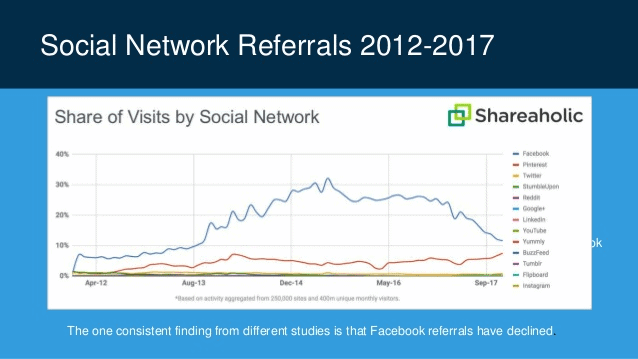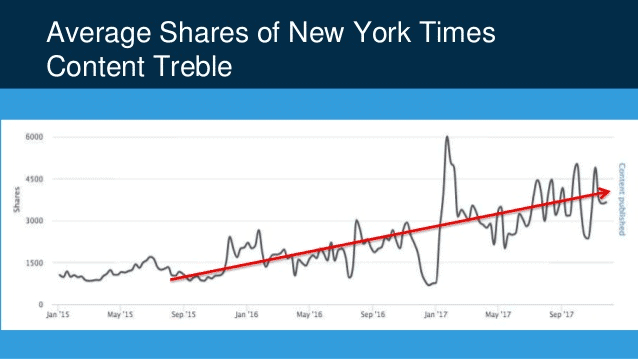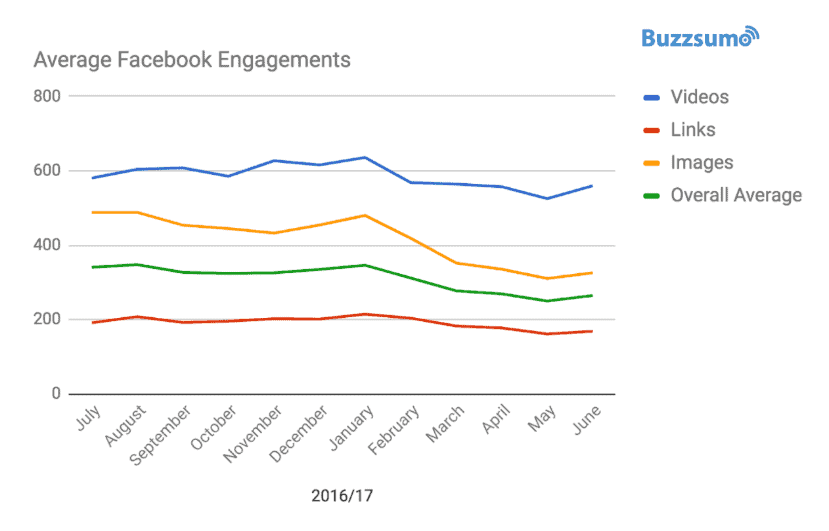In their latest Content Trends Research Report, BuzzSumo revealed some eye-opening findings for social marketers.
Overall, social sharing is on the decline, and the trend shows no sign of slowing down through the rest of this year and beyond.
What accounts for this downward trend, and is there anything retailers can do in response?
Michael Quoc, the founder and CEO of Dealspotr, a social shopping community and influencer marketing tool, has these insights.
Social sharing on the decline and other key findings from the BuzzSumo report
BuzzSumo analyzed 100 million posts last year to put together their report. The main takeaway is this: social shares have plummeted since 2015, dropping by half. Corresponding with that change is a large drop in social referral traffic.
Perhaps more interesting than the drop itself is the cause for it. BuzzSumo attributes the declining social sharing problem to three main culprits:
- An ever-changing Facebook algorithm
- The rise of dark social sharing
- And increased competition among brands and publishers
Facebook used to be the largest driver of social referral traffic. However, this graph clearly shows the recent and steady decline in Facebook shares:
Marketers should expect this downward trend from Facebook to continue, considering the January announcement from Mark Zuckerberg to de-prioritize content from brands and publishers. Unsurprisingly, Google has overtaken Facebook as the main source of referral traffic again.
Another sweeping change has taken place in regards to what types of content drive social shares. BuzzSumo found that clickbait headlines and listicle posts are much less effective than they used to be. Sites like BuzzFeed and Upworthy, known for their clickbait-style reporting, used to reign supreme on the social networks. Now, those same sites are experiencing a decline in social performance.
Making matters even tougher is the increased competition of publishers overall. More and more sites are beefing up their content marketing programs, clamoring to churn out content on a near-constant basis. Content publication hasn’t slowed down – it’s only increased. As a result, publishers are running into content overwhelm and fatigue from an audience that hasn’t grown to meet demand.
However, some sites have found a way to not only weather the storm, but actually improve and see an uptick in traffic. The sites still earning social shares are the ones who have made a name for themselves as authoritative, original sources of content. Here’s an example showing the increased social shares for The New York Times:
Another unexpected area of good news? Both social sharing and engagement rates have increased on LinkedIn, as B2B marketers will be happy to hear.
However, the overall analysis is bleak: fewer posts stand a chance of going viral at all, so what are retailers to do?
Recommendations for retailers in a declining social sharing landscape
Fortunately, all is not lost. The reality is, though, that marketers will have to put in real work to stay competitive. Follow these five suggestions to set your business up for success.
1. Go for engagement, not referral traffic.
At a high level, marketers need to reevaluate their strategy and goals for social media.
Retailers should rely on social media for in-platform engagement, and pivot the content they generate for those platforms to serve those needs. Otherwise they can expect to be deprioritized in the main feeds. Social media engagement should be the top priority, not driving referral traffic.
In the chart below, it’s important to note that posts with links perform well below the overall average, reinforcing that Facebook is not interested in driving traffic off the platform to your website:
Observe where your audience lives. Then invest in those platforms by creating unique content for each one. Give your most loyal followers a compelling reason to check in to each of your profiles to avoid FOMO. This regular engagement sends positive signals back to the platforms, so they’re more likely to consistently show you in users’ main feeds.
Also, take time to build out your Messenger strategy to engage customers. Chat apps like Facebook Messenger offer brands a direct line of communication to customers while they’re on Facebook. Social customer service is no longer opt-in; it’s required.
2. Quality is no longer optional.
Another thing that’s no longer optional? High-quality content.
Moving forward, content should be free of clickbait titles and gimmicks aimed to drive virality. Instead, marketers should focus on creating the most authoritative, deeply helpful content that their audience will find extremely valuable. Spend more time and effort on individual, in-depth pieces (whether they’re in written or video form), instead of churning and burning on a bunch of surface-level articles.
Always supplement your content with more than one media:
- Showcase original images that compel users to share
- Turn a blog post into a video or podcast
- Create interactive quizzes
When it comes to engagement, video remains the most popular type of social media content, boasting twice the engagement rates of others. Live video especially is highly prioritized and rewarded by the Facebook algorithm. Post your Facebook Live videos afterwards to YouTube for posterity, and follow SEO best practices to improve their rank in both YouTube and Google search.
According to the BuzzSumo report, evergreen content is another type of content that consistently performs well in a fickle social landscape. When developing evergreen content, make sure yours is backed by research, covers a perennially popular topic, and is updated regularly.
3. Build trust and authority through smart promotion.
In today’s world of fake news, establishing your site as an authority is increasingly important for success in both the SERPs and social media. To build authority, start by developing high-quality content as we discussed in the point above.
Then, get to work promoting it.
Promotion is more critical than ever. Use all channels at your disposal to drive views. If you have a new report, create a YouTube video highlighting the key takeaways and send clicks to your website. Invest in Facebook advertising to get your high-quality content in front of a larger audience, and in turn, encourage more organic (free) shares. Encourage customers to unlock your content via scannable QR codes at your retail locations. Finally, don’t forget your email marketing and browser push notifications as additional channels for driving traffic.
4. Put your audience first.
An engaged, loyal audience is also a huge trust indicator and authority signal. To succeed with content, marketers need to give consumers a reason to return directly to your website over and over again, as they won’t be finding it through social media. This loyalty will pay off in engagement as well as other metrics that boost your company’s bottom line.
Spend more time rewarding your most engaged, direct audience channels with exclusive content and promotions. Treat your web visitors, blog and email subscribers, and rewards members like VIPs, instead of chasing after unknowns on social media.
Offer gamified experiences on your website, or develop thrilling content series that users can only access during a limited time. Focus on experiential marketing through apps, event marketing, and augmented reality to drive customers back to your website for more information.
5. Invest in influencer marketing and UGC.
The changing algorithms of Instagram, Facebook, and other social platforms, along with increasingly crowded SERPs are making it harder for individual websites and profiles to stand out. As a result, retailers will need to increasingly rely on their own customers to promote their brand and help raise their visibility.
User-generated content (UGC) goes beyond customer reviews and testimonials, although those are still important. Influencer marketing offers brands a way to reach more customers through individuals who have built up the authority social networks reward with visibility in their main feeds.
Consumers trust other consumers more than your brand. It’s as simple as that. They’re seven times likelier to trust an image from another consumer over one from your brand, and 56% more likely to purchase something after seeing a positive review. And consumers are effective promoters for brands: UGC mentioning a brand gets seven times the engagement of a Facebook post from the brand itself.
B2B marketers can derive a lot of value from LinkedIn in particular. Work with prominent employees who have well-rounded personal brands to create an influencer marketing strategy for the platform. Develop content for LinkedIn Publisher and share engaging posts to your company page that your audience can’t help but respond to.
Conclusion
These changes are forcing marketers to return their focus to what social media was originally designed for: to drive engagement on-platform, not traffic off it.
By truly engaging your audience with meaningful content, instead of clickbaiting them with shallow blog posts, your brand can develop stronger relationships with customers that drive both social engagement and website visits.








